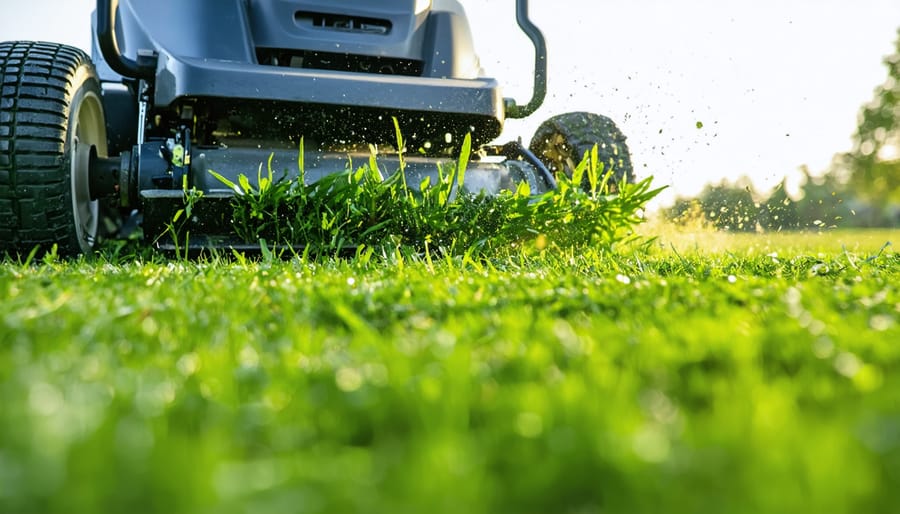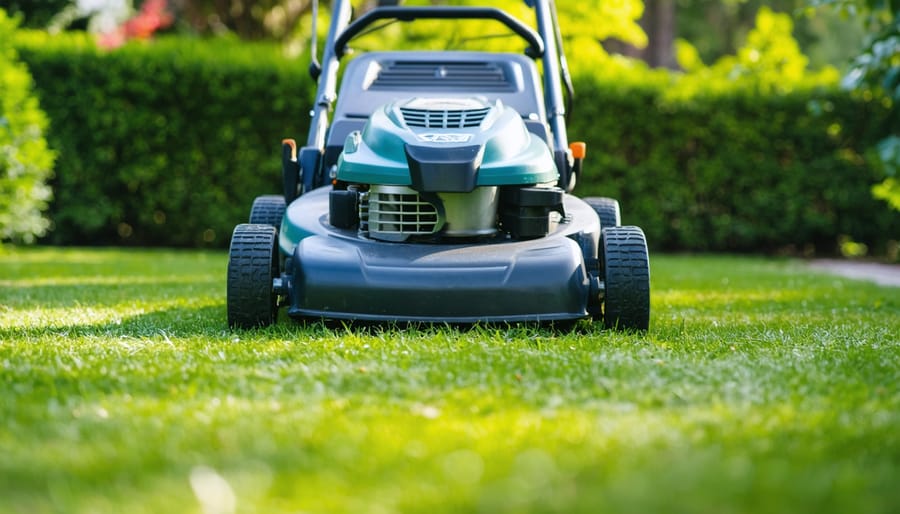Navigate the complex world of zero-turn mowers with our comprehensive comparison chart, designed to help you make a confident purchase decision. Understanding the zero-turn vs lawn tractor differences is just the beginning – today’s market offers dozens of zero-turn models with varying features, capabilities, and price points. Our detailed analysis breaks down essential specifications like cutting width, engine horsepower, fuel efficiency, and deck construction across leading brands including Husqvarna, John Deere, and Toro. Whether you’re maintaining a small residential lawn or managing extensive commercial properties, this data-driven comparison eliminates guesswork from your selection process. We’ve meticulously evaluated each model’s performance metrics, durability factors, and user comfort features to create a straightforward, easy-to-reference guide that helps match the perfect zero-turn mower to your specific needs and budget.
Understanding the Comparison Metrics
Performance Indicators
Performance indicators are crucial metrics that help you understand what each zero-turn mower can deliver. Cutting width typically ranges from 42 inches to 72 inches, with residential models usually falling between 42-54 inches. A wider deck means fewer passes to complete your lawn, but remember that larger decks may limit maneuverability in tight spaces.
Speed is another vital factor, with most zero-turn mowers capable of forward speeds between 6-8 mph and reverse speeds of 3-4 mph. Commercial models can reach up to 12 mph, though it’s worth noting that faster isn’t always better when it comes to achieving a precise, even cut.
Engine power varies significantly across models, typically ranging from 20 to 31 horsepower. Residential models usually offer 20-25 HP, which is plenty for most home lawns. Commercial-grade mowers often feature engines delivering 25-31 HP, providing the extra muscle needed for prolonged use and challenging conditions.
When comparing these metrics, consider your specific needs: A half-acre lot might be perfectly served by a 42-inch deck with a 20 HP engine, while larger properties may benefit from increased cutting width and power.
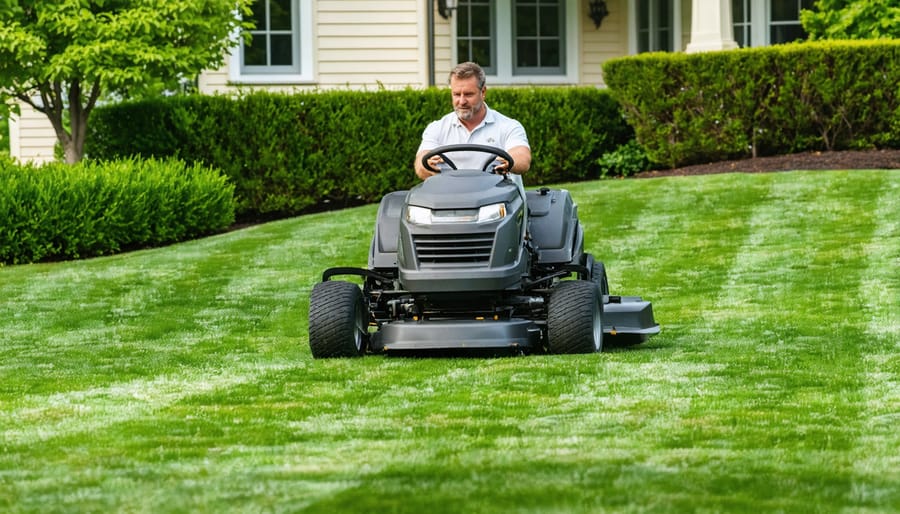
Comfort and Usability Features
When comparing zero-turn mowers, the operator’s comfort and ease of use significantly impact overall satisfaction. Modern mowers feature innovative zero-turn features designed to reduce fatigue during long mowing sessions. High-back seats with armrests and adjustable positioning ensure proper posture, while comfort suspension systems help absorb shock from uneven terrain.
Control layouts vary between manufacturers, but most utilize dual lap bars for intuitive steering. Look for models with cushioned, adjustable-tension levers that respond smoothly to operator input. Ergonomic considerations extend to dashboard placement, with easily accessible control panels featuring clear displays and conveniently positioned switches.
Some premium models include cup holders, phone storage compartments, and USB charging ports for added convenience. Step-through decks make mounting and dismounting safer, while adjustable foot platforms accommodate operators of different heights. Pay special attention to models offering tool-free adjustments for quick customization of your riding experience.

Detailed Comparison Chart Analysis
Entry-Level Models
When exploring entry-level zero-turn models, there are several excellent options available for homeowners working with a budget under $4,000. These affordable mowers offer impressive features without breaking the bank, making them perfect for those new to zero-turn technology.
The Husqvarna Z142 stands out in this category, offering a reliable 17HP Kohler engine and 42-inch cutting deck at around $3,200. It delivers excellent maneuverability and consistent cutting performance, ideal for properties up to 2 acres. The Ariens Edge 34 is another strong contender, priced at approximately $3,400, featuring a 34-inch deck perfect for navigating tight spaces and a robust 19HP Kohler engine.
For those seeking maximum deck width in this price range, the Troy-Bilt Mustang 46-inch provides exceptional value at roughly $3,800. Its 24HP engine and larger cutting width make quick work of medium-sized lawns while maintaining good fuel efficiency. The Cub Cadet Ultima ZT1 42 deserves mention for its premium features at around $3,600, including a comfortable high-back seat and advanced deck washing system.
These budget-friendly options all include essential features like dual hydrostatic transmissions, sturdy steel frames, and decent warranty coverage. While they may not offer the advanced features of premium models, they provide reliable performance and durability for regular home use. When comparing these models, focus on deck size, engine power, and comfort features that match your specific lawn care needs and property size.
Mid-Range Professional Models
In the mid-range professional category ($4,000-$7,000), you’ll find an impressive selection of zero-turn mowers that balance professional-grade features with reasonable pricing. These models typically offer cutting deck sizes between 48 and 60 inches, making them ideal for properties between 2 and 5 acres.
Notable standouts in this category include the Hustler Raptor XD, which consistently receives high marks for its commercial-grade transmission and robust 23 HP engine. The Toro TimeCutter HD series offers exceptional cut quality with its proprietary MyRIDE suspension system, providing superior operator comfort during extended mowing sessions.
For those prioritizing fuel efficiency, the Ariens Ikon XD models feature electronic fuel injection (EFI) systems that optimize fuel consumption while delivering consistent power. The Kubota Z400 series stands out for its commercial-grade durability and precision engineering, though it tends toward the higher end of this price range.
Key features commonly found in this category include:
– Heavy-duty steel frame construction
– Commercial or professional-grade hydrostatic transmissions
– Enhanced suspension systems
– LED lighting packages
– Premium seat cushioning with armrests
– 3-4 year warranties
These mowers typically achieve speeds of 8-10 mph and offer excellent maneuverability around landscape features. While they may not have all the premium features of commercial models, they provide professional-quality results and reliability that satisfy most demanding homeowners and part-time landscapers. Many users report these machines lasting 8-10 years with proper maintenance, making them a sound investment for serious lawn care enthusiasts.
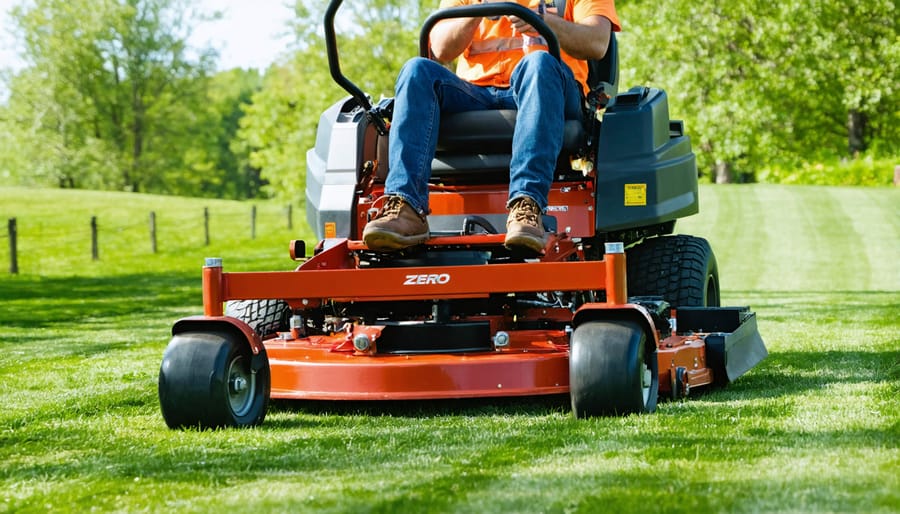
Premium Commercial Grade
When stepping into the premium commercial-grade category of zero-turn mowers, you’re entering the realm of professional-level equipment designed for extensive use and superior performance. These machines, priced above $7,000, offer unmatched durability, cutting precision, and operator comfort that justify their significant investment.
Leading models in this category typically feature powerful engines ranging from 25 to 38 HP, professional-grade hydrostatic transmissions, and cutting decks spanning 60 to 72 inches. The build quality is exceptional, with heavy-duty welded steel frames and commercial-grade components designed to withstand daily use. Their performance on difficult terrain is particularly impressive, thanks to advanced suspension systems and high-capacity drive systems.
What sets these premium mowers apart is their attention to professional needs. Features like advanced monitoring systems, hour meters, and sophisticated maintenance alerts help operators track performance and schedule upkeep. The comfort features are equally impressive, with ergonomic high-back seats, adjustable armrests, and advanced vibration dampening systems that reduce operator fatigue during long mowing sessions.
Fuel efficiency is another standout characteristic, with many models incorporating advanced fuel management systems and large-capacity tanks that enable extended operation times. The cutting systems often include professional-grade blades, enhanced bagging capabilities, and precise height adjustment mechanisms that deliver a golf course-quality finish.
While the initial investment might seem steep, these mowers typically offer the lowest cost per hour of operation when used regularly. Their robust construction means fewer repairs, longer service intervals, and exceptional resale value. For commercial operators or those maintaining large properties, these premium models can actually represent better value over time compared to less expensive alternatives.
These machines also often come with extended commercial warranties and dedicated dealer support networks, ensuring minimal downtime and professional-level service when needed. For operations where mowing efficiency and reliability are crucial, these premium commercial-grade mowers deliver unmatched performance and long-term value.
Environmental Impact and Efficiency
Fuel Consumption Comparison
Fuel consumption is a crucial factor when comparing zero-turn mowers, as it directly impacts both operating costs and environmental footprint. Most residential zero-turn mowers consume between 1 to 2 gallons of fuel per hour, though this can vary significantly based on mowing conditions and operation style.
In our comparison, we found that commercial-grade models like the Toro TimeCutter and Husqvarna Z254F typically offer better fuel efficiency, averaging 1.2 gallons per hour under normal mowing conditions. Mid-range models such as the John Deere Z335E and Cub Cadet Ultima ZT1 show slightly higher consumption at around 1.5 gallons per hour.
Several factors influence fuel consumption:
– Engine size and horsepower
– Terrain type and grass conditions
– Mowing speed and technique
– Maintenance status of the mower
To maximize fuel efficiency:
– Maintain a consistent mowing speed
– Keep blades sharp
– Service the air filter regularly
– Avoid mowing wet grass
– Use the recommended fuel type
For perspective, a typical 2-acre lawn might require 2-3 gallons of fuel per mowing session. Some newer models feature eco-modes that can reduce consumption by up to 20%. When comparing models, look for those with fuel injection systems, as they typically offer better fuel economy than carbureted engines.
Remember that while initial purchase price is important, fuel efficiency can significantly impact long-term ownership costs.
Environmental Features
Modern zero-turn mowers are increasingly incorporating eco-friendly features that help reduce their environmental impact while maintaining excellent performance. Many manufacturers now offer electric and hybrid models, which significantly reduce emissions and noise pollution compared to traditional gas-powered units. These environmentally conscious options typically operate at around 75-85 decibels, notably quieter than conventional mowers that can exceed 95 decibels.
Several models come equipped with smart fuel management systems that optimize fuel consumption and reduce emissions. Some manufacturers have introduced biodegradable hydraulic fluids as an alternative to traditional oils, minimizing potential environmental damage in case of leaks. Advanced mulching systems are another eco-friendly feature, allowing clippings to naturally decompose and return nutrients to your lawn, reducing the need for chemical fertilizers.
Battery-powered zero-turn mowers are gaining popularity, with some models offering up to 3-4 hours of runtime on a single charge. While they typically come with a higher initial cost, they require less maintenance and have lower operating costs over time. Many models also feature programmable eco-modes that adjust power output based on grass conditions, further improving efficiency.
For those still preferring gas models, look for EPA-compliant engines with advanced filtration systems and catalytic converters. Some manufacturers have also introduced solar-powered accessories for their mowers, such as battery maintainers and digital displays, showing a commitment to incorporating renewable energy solutions.
Maintenance and Long-Term Value
Service Intervals
Regular maintenance is crucial for keeping your zero-turn mower performing at its best, and service intervals vary between different models and manufacturers. Most residential zero-turn mowers require oil changes every 50-100 operating hours, while commercial models might need them every 100-200 hours, depending on usage intensity and conditions.
Air filters should be checked before each use and cleaned or replaced every 25 operating hours or more frequently in dusty conditions. The spark plugs typically need inspection every 100 hours and replacement at 200 hours or annually, whichever comes first. Fuel filters should be replaced annually or every 200 hours of operation.
Belt inspection is recommended every 50 hours, with replacement needed when signs of wear appear. Blade sharpening should occur every 25 hours of operation, though this may vary based on your terrain and grass type. It’s essential to check and grease all fittings every 25 hours of operation to maintain smooth movement and prevent wear.
Battery maintenance is typically minimal, but terminals should be cleaned and connections checked monthly during the mowing season. Tire pressure should be checked weekly during regular use to ensure even cutting and optimal performance.
Keep in mind that these are general guidelines, and your specific model’s owner’s manual may recommend different intervals. Creating a maintenance log can help track service dates and hours, ensuring you never miss crucial maintenance tasks. Many modern zero-turn mowers come with hour meters to help monitor usage and maintain appropriate service schedules.
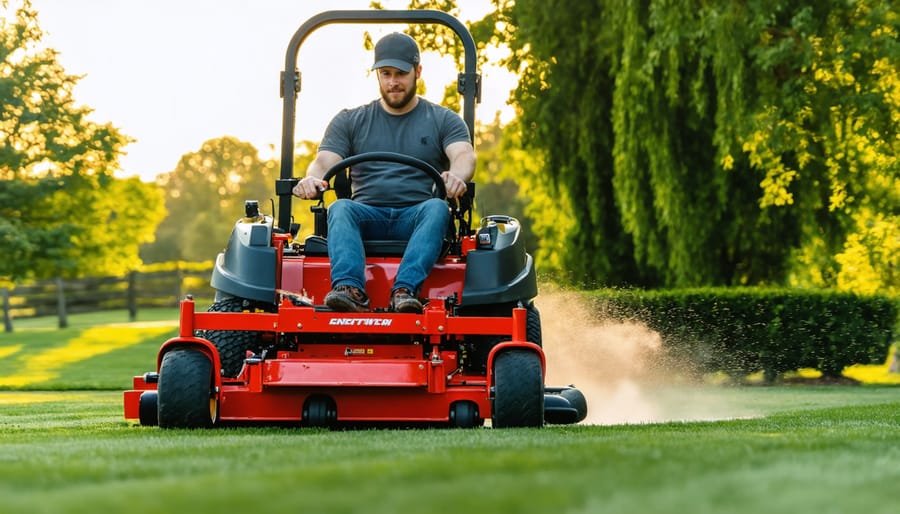
Cost of Ownership
Understanding the total cost of ownership for a zero-turn mower goes beyond the initial purchase price. While premium models might command higher upfront costs, ranging from $3,000 to $15,000, they often prove more economical in the long run due to their durability and efficiency.
Fuel consumption is a significant ongoing expense. Commercial-grade zero-turn mowers typically offer better fuel efficiency, consuming 1-2 gallons per hour compared to entry-level models that might use up to 2.5 gallons per hour. Over a season, this difference can amount to hundreds of dollars in fuel savings.
Maintenance costs vary significantly between models. Professional-grade machines with robust construction and high-quality components generally require less frequent repairs, though their replacement parts may cost more. Budget models might need more frequent maintenance, with annual maintenance costs ranging from $200 to $800, depending on usage and model type.
Resale value is another crucial consideration. Well-maintained commercial-grade zero-turn mowers typically retain 40-50% of their value after five years, while residential models might only maintain 25-35%. This difference can significantly impact the total cost of ownership when it’s time to upgrade.
Insurance and storage costs should also factor into your decision. Some models require covered storage to maintain warranty coverage, and insurance costs can vary based on the mower’s value and intended use. Consider these ongoing expenses when comparing different models, as they contribute significantly to the total cost of ownership over the mower’s lifetime.
After examining various zero-turn mowers across different categories and price points, it’s clear that the perfect choice depends heavily on your specific needs and circumstances. For homeowners with smaller lawns up to 1 acre, residential models like the John Deere Z345R or the Husqvarna Z246 offer excellent value, combining good cutting performance with user-friendly features at a reasonable price point.
For those managing larger properties between 1-3 acres, mid-range options such as the Toro TimeCutter or Ariens IKON XD provide the ideal balance of durability, comfort, and cutting efficiency. These models typically offer enhanced features like more powerful engines and wider cutting decks while maintaining manageable price tags.
Professional landscapers and those maintaining extensive properties should consider commercial-grade models like the Exmark Lazer Z or Scag Patriot. While these come with higher price tags, their superior build quality, enhanced productivity features, and longer service life make them cost-effective long-term investments.
When making your final decision, consider these key factors:
– Property size and terrain type
– Budget constraints (including maintenance costs)
– Desired cutting width and speed
– Storage space availability
– Required comfort features
For the environmentally conscious, several manufacturers now offer electric zero-turn options. While these typically have shorter running times and higher initial costs, they provide zero emissions and lower operating costs over time.
Remember that the most expensive option isn’t always the best for your situation. Focus on matching the mower’s capabilities to your specific needs rather than being swayed by premium features you may never use. Consider factors like local dealer support, parts availability, and warranty coverage in your final decision.
For optimal longevity and performance, whichever model you choose, maintain a regular service schedule and follow manufacturer guidelines for operation and maintenance. This investment in proper care will ensure your zero-turn mower provides reliable service for years to come.
